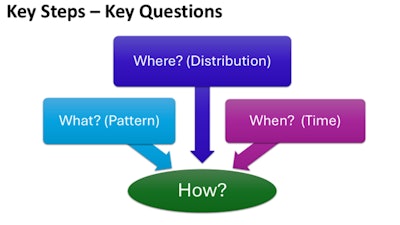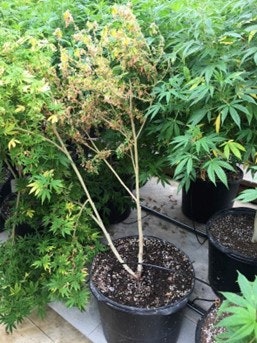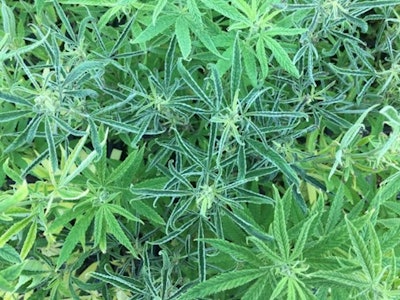Vegetation, like people, can show off well being issues for numerous causes, and as with people, signs regularly exist that can lend a hand diagnose the drawback. By means of the use of a diagnostic-like procedure, you’ll resolve the reason for the issue and make corrections for your rising practices to resolve it in addition to keep away from long term issues.
The 3 major questions of the diagnostic procedure are: what (trend), the place (distribution), and when (time/time period) (Fig. 1). Coming near plant diagnostics with those elementary questions in thoughts allow you to focal point your consideration on successfully saving your crop in a probably high-stress second.
Query 1: What? Fig. 1. The 3 major questions used to visually diagnose an issue are the place, what, and when. All 3 should be applied to make an educated analysis.Photograph by way of Dr. Brian E. Whipker
Fig. 1. The 3 major questions used to visually diagnose an issue are the place, what, and when. All 3 should be applied to make an educated analysis.Photograph by way of Dr. Brian E. Whipker
When figuring out if the issue is the results of biotic (pathogen or insect) or abiotic (dietary or physiological) foundation, a key step is in search of signs at the foliage—what is the trend at the plant?
For those who had been to take a leaf showing signs and draw a line down the middle (see Fig. 2), are the indications symmetrical? If the leaf signs aren’t symmetrical, normally this issues you within the route of biotic issues corresponding to pathogens or insect injury (see Fig. 2(A.)). If the indications seem symmetrically on the leaf, it is a robust indication that you’re experiencing an abiotic drawback corresponding to dietary deficiency or physiological motive (see Fig. 2(B.)).
This easy check is very best carried out on leaves that experience signs masking ~33% in their floor. In a different way, vital early well being factor proof might be misplaced. For instance, the trend distinction is noticeable on the preliminary an infection of powdery mold, however the illness will ultimately unfold and canopy all of the leaf floor, thus negating this diagnostic take a look at. That is one more reason to have a just right and constant scouting program to catch issues early. Fig. 2: When figuring out the trend on a leaf, imagining a line down the middle of the leaflet and figuring out whether it is symmetrical is a useful device in figuring out if the issue is biotic (nonsymmetrical, corresponding to with powdery mold as observed at the A facet) or abiotic (symmetrical, as with magnesium deficiency at the B facet).Photograph by way of Dr. Brian E. Whipker
Fig. 2: When figuring out the trend on a leaf, imagining a line down the middle of the leaflet and figuring out whether it is symmetrical is a useful device in figuring out if the issue is biotic (nonsymmetrical, corresponding to with powdery mold as observed at the A facet) or abiotic (symmetrical, as with magnesium deficiency at the B facet).Photograph by way of Dr. Brian E. Whipker
Query 2: The place?
The next move is having a look at symptom distribution—wright here within the greenhouse or at the plant are the issues going on?
If the distribution of impacted crops is non-uniform, corresponding to scattered crops or wallet all through the rising house, you’ll begin to suspect biotic issues (see Fig. 3). For instance, all through mite infestations, a small choice of crops usually will probably be to start with infested prior to spreading to surrounding crops. Any other biotic instance is Pythium root rot, which is able to have a tendency first of all a unmarried plant among many wholesome ones.
By contrast, if the issue is frivolously dispensed and/or uniform all through all of the rising house or at one finish of the greenhouse in comparison to the opposite, you can begin to suspect abiotic issues (see Fig. 4). For instance, if a whole greenhouse bench is showing equivalent signs, the irrigation apparatus must be checked for correct serve as. Fig. 3: When unmarried crops or clustered crops are showing issues, this issues to biotic issues going on corresponding to Pythium root rot (proven right here) or bugs.Photograph by way of Dr. Brian E. Whipker
Fig. 3: When unmarried crops or clustered crops are showing issues, this issues to biotic issues going on corresponding to Pythium root rot (proven right here) or bugs.Photograph by way of Dr. Brian E. Whipker
Moreover, believe the place at the plant the issue is going on: Is it at the roots, stem, higher or decrease foliage, or at the floral construction? Breaking a plant down into portions will clue you into what the prospective drawback might be. For instance, many micronutrient deficiencies seem within the more youthful foliage, whilst macronutrient deficiencies of nitrogen, phosphorus, potassium and magnesium normally happen within the decrease foliage.
Query 3: When?
Onset and period–wchicken and or how lengthy did it take visible signs to manifest are necessary questions to respond to since they are able to get rid of many issues that show off equivalent signs.
When signs seem briefly—inside of 24 to 72 hours—you’ll suspect abiotic issues corresponding to chemical phytotoxicity (see Fig. 5), environmental strain, or nutrient toxicity. If signs seem regularly—over one to 4 weeks—the prospective listing of culprits is a lot better and comprises sicknesses, insect injury (Fig. 6) or dietary deficiencies. Fig. 4: If a whole greenhouse or flat is showing equivalent issues, this issues to abiotic problems corresponding to low fertility (proven above), or physiological issues.Photograph by way of Dr. Brian E. Whipker
Fig. 4: If a whole greenhouse or flat is showing equivalent issues, this issues to abiotic problems corresponding to low fertility (proven above), or physiological issues.Photograph by way of Dr. Brian E. Whipker
Comparing
Using those 3 questions can lend a hand slender down the prospective motive(s) of the issues that you’re gazing for your crop (see Fig. 1). Fig. 5: Speedy building of visible signs (inside of 48-72 hours) directs your consideration to abiotic issues corresponding to chemical phytotoxicity (proven above), or water strain.Photograph by way of Dr. Brian E. Whipker
Fig. 5: Speedy building of visible signs (inside of 48-72 hours) directs your consideration to abiotic issues corresponding to chemical phytotoxicity (proven above), or water strain.Photograph by way of Dr. Brian E. Whipker
Whilst this is a superb place to begin for narrowing down the probabilities, oftentimes issues can happen together and will make diagnostics harder, corresponding to nutrient-stressed crops being extra prone to illness, or root rot resulting in iron deficiencies.
Figuring out the reasons of the issues is the most important step to fighting issues in long term rising seasons. Moreover, finding out the highest issues that you simply steadily come across will assist you to make knowledgeable selections for prevention or early analysis and remedy.  Fig. 6: When visible signs take longer to manifest or accentuate over the years, you’ll begin to shift your consideration to insect injury (above), pathogens, or nutrient deficiencies.Photograph by way of Dr. Brian E. Whipker
Fig. 6: When visible signs take longer to manifest or accentuate over the years, you’ll begin to shift your consideration to insect injury (above), pathogens, or nutrient deficiencies.Photograph by way of Dr. Brian E. Whipker
Patrick Veazie, Paul Cockson, and Brian E. Whipker are researchers with North Carolina State College in Raleigh, N.C. Whipker could also be a professor and business floriculture extension and analysis specialist.
Vegetation, like people, can show off well being issues for numerous causes, and as with people, signs regularly exist that can lend a hand diagnose the drawback. By means of the use of a diagnostic-like procedure, you’ll resolve the reason for the issue and make corrections for your rising practices to resolve it in addition to keep away from long term issues.
The 3 major questions of the diagnostic procedure are: what (trend), the place (distribution), and when (time/time period) (Fig. 1). Coming near plant diagnostics with those elementary questions in thoughts allow you to focal point your consideration on successfully saving your crop in a probably high-stress second.
Query 1: What? Fig. 1. The 3 major questions used to visually diagnose an issue are the place, what, and when. All 3 should be applied to make an educated analysis.Photograph by way of Dr. Brian E. Whipker
Fig. 1. The 3 major questions used to visually diagnose an issue are the place, what, and when. All 3 should be applied to make an educated analysis.Photograph by way of Dr. Brian E. Whipker
When figuring out if the issue is the results of biotic (pathogen or insect) or abiotic (dietary or physiological) foundation, a key step is in search of signs at the foliage—what is the trend at the plant?
For those who had been to take a leaf showing signs and draw a line down the middle (see Fig. 2), are the indications symmetrical? If the leaf signs aren’t symmetrical, normally this issues you within the route of biotic issues corresponding to pathogens or insect injury (see Fig. 2(A.)). If the indications seem symmetrically on the leaf, it is a robust indication that you’re experiencing an abiotic drawback corresponding to dietary deficiency or physiological motive (see Fig. 2(B.)).
This easy check is very best carried out on leaves that experience signs masking ~33% in their floor. In a different way, vital early well being factor proof might be misplaced. For instance, the trend distinction is noticeable on the preliminary an infection of powdery mold, however the illness will ultimately unfold and canopy all of the leaf floor, thus negating this diagnostic take a look at. That is one more reason to have a just right and constant scouting program to catch issues early. Fig. 2: When figuring out the trend on a leaf, imagining a line down the middle of the leaflet and figuring out whether it is symmetrical is a useful device in figuring out if the issue is biotic (nonsymmetrical, corresponding to with powdery mold as observed at the A facet) or abiotic (symmetrical, as with magnesium deficiency at the B facet).Photograph by way of Dr. Brian E. Whipker
Fig. 2: When figuring out the trend on a leaf, imagining a line down the middle of the leaflet and figuring out whether it is symmetrical is a useful device in figuring out if the issue is biotic (nonsymmetrical, corresponding to with powdery mold as observed at the A facet) or abiotic (symmetrical, as with magnesium deficiency at the B facet).Photograph by way of Dr. Brian E. Whipker
Query 2: The place?
The next move is having a look at symptom distribution—wright here within the greenhouse or at the plant are the issues going on?
If the distribution of impacted crops is non-uniform, corresponding to scattered crops or wallet all through the rising house, you’ll begin to suspect biotic issues (see Fig. 3). For instance, all through mite infestations, a small choice of crops usually will probably be to start with infested prior to spreading to surrounding crops. Any other biotic instance is Pythium root rot, which is able to have a tendency first of all a unmarried plant among many wholesome ones.
By contrast, if the issue is frivolously dispensed and/or uniform all through all of the rising house or at one finish of the greenhouse in comparison to the opposite, you can begin to suspect abiotic issues (see Fig. 4). For instance, if a whole greenhouse bench is showing equivalent signs, the irrigation apparatus must be checked for correct serve as. Fig. 3: When unmarried crops or clustered crops are showing issues, this issues to biotic issues going on corresponding to Pythium root rot (proven right here) or bugs.Photograph by way of Dr. Brian E. Whipker
Fig. 3: When unmarried crops or clustered crops are showing issues, this issues to biotic issues going on corresponding to Pythium root rot (proven right here) or bugs.Photograph by way of Dr. Brian E. Whipker
Moreover, believe the place at the plant the issue is going on: Is it at the roots, stem, higher or decrease foliage, or at the floral construction? Breaking a plant down into portions will clue you into what the prospective drawback might be. For instance, many micronutrient deficiencies seem within the more youthful foliage, whilst macronutrient deficiencies of nitrogen, phosphorus, potassium and magnesium normally happen within the decrease foliage.
Query 3: When?
Onset and period–wchicken and or how lengthy did it take visible signs to manifest are necessary questions to respond to since they are able to get rid of many issues that show off equivalent signs.
When signs seem briefly—inside of 24 to 72 hours—you’ll suspect abiotic issues corresponding to chemical phytotoxicity (see Fig. 5), environmental strain, or nutrient toxicity. If signs seem regularly—over one to 4 weeks—the prospective listing of culprits is a lot better and comprises sicknesses, insect injury (Fig. 6) or dietary deficiencies. Fig. 4: If a whole greenhouse or flat is showing equivalent issues, this issues to abiotic problems corresponding to low fertility (proven above), or physiological issues.Photograph by way of Dr. Brian E. Whipker
Fig. 4: If a whole greenhouse or flat is showing equivalent issues, this issues to abiotic problems corresponding to low fertility (proven above), or physiological issues.Photograph by way of Dr. Brian E. Whipker
Comparing
Using those 3 questions can lend a hand slender down the prospective motive(s) of the issues that you’re gazing for your crop (see Fig. 1). Fig. 5: Speedy building of visible signs (inside of 48-72 hours) directs your consideration to abiotic issues corresponding to chemical phytotoxicity (proven above), or water strain.Photograph by way of Dr. Brian E. Whipker
Fig. 5: Speedy building of visible signs (inside of 48-72 hours) directs your consideration to abiotic issues corresponding to chemical phytotoxicity (proven above), or water strain.Photograph by way of Dr. Brian E. Whipker
Whilst this is a superb place to begin for narrowing down the probabilities, oftentimes issues can happen together and will make diagnostics harder, corresponding to nutrient-stressed crops being extra prone to illness, or root rot resulting in iron deficiencies.
Figuring out the reasons of the issues is the most important step to fighting issues in long term rising seasons. Moreover, finding out the highest issues that you simply steadily come across will assist you to make knowledgeable selections for prevention or early analysis and remedy.  Fig. 6: When visible signs take longer to manifest or accentuate over the years, you’ll begin to shift your consideration to insect injury (above), pathogens, or nutrient deficiencies.Photograph by way of Dr. Brian E. Whipker
Fig. 6: When visible signs take longer to manifest or accentuate over the years, you’ll begin to shift your consideration to insect injury (above), pathogens, or nutrient deficiencies.Photograph by way of Dr. Brian E. Whipker
Patrick Veazie, Paul Cockson, and Brian E. Whipker are researchers with North Carolina State College in Raleigh, N.C. Whipker could also be a professor and business floriculture extension and analysis specialist.















